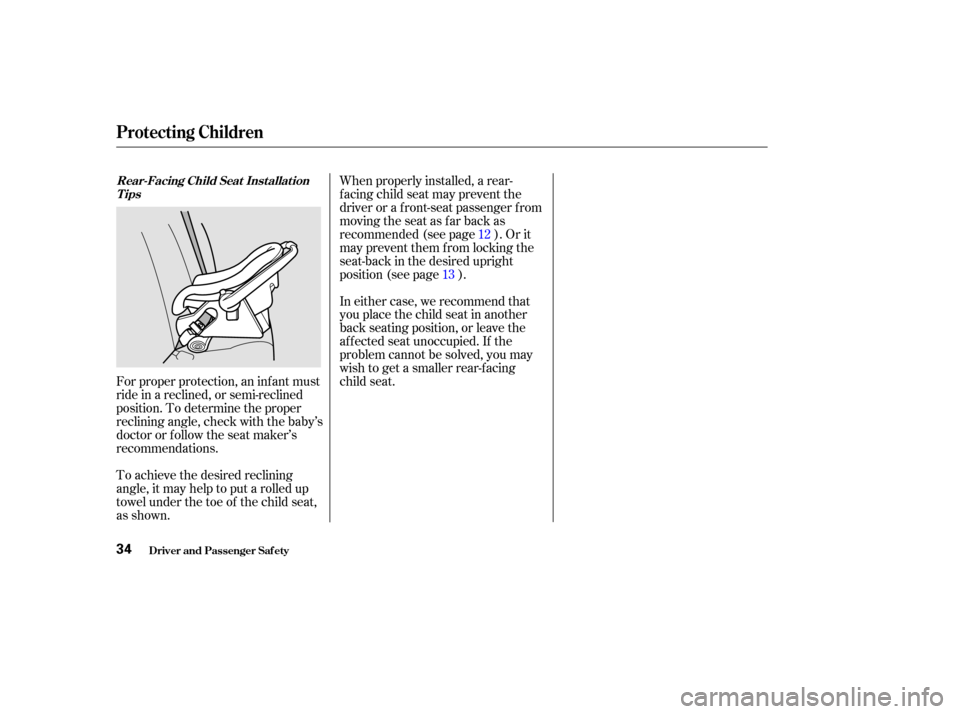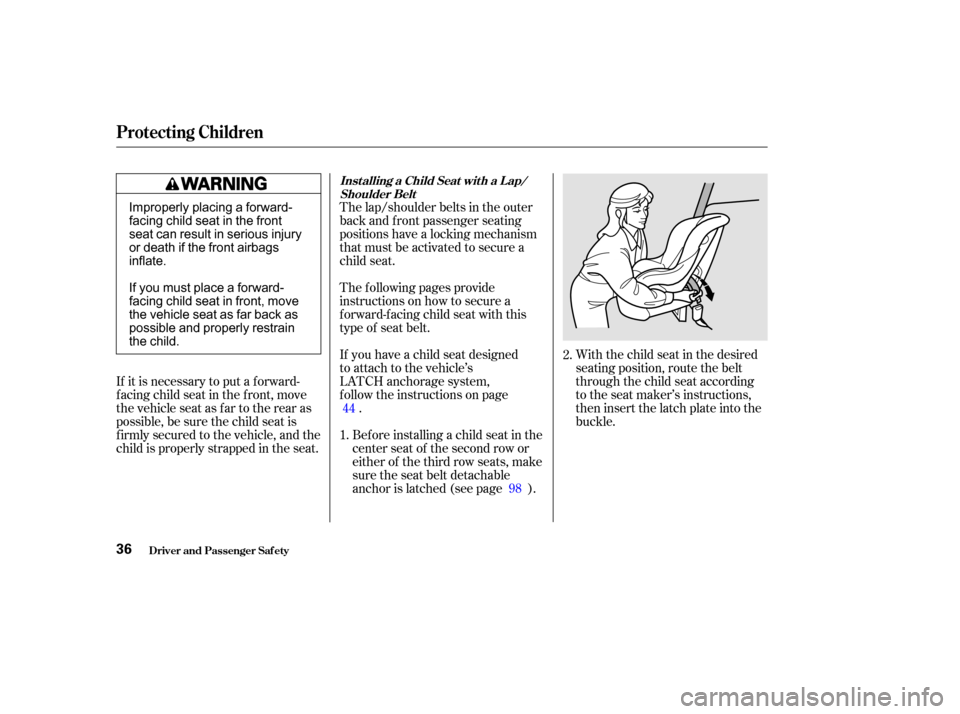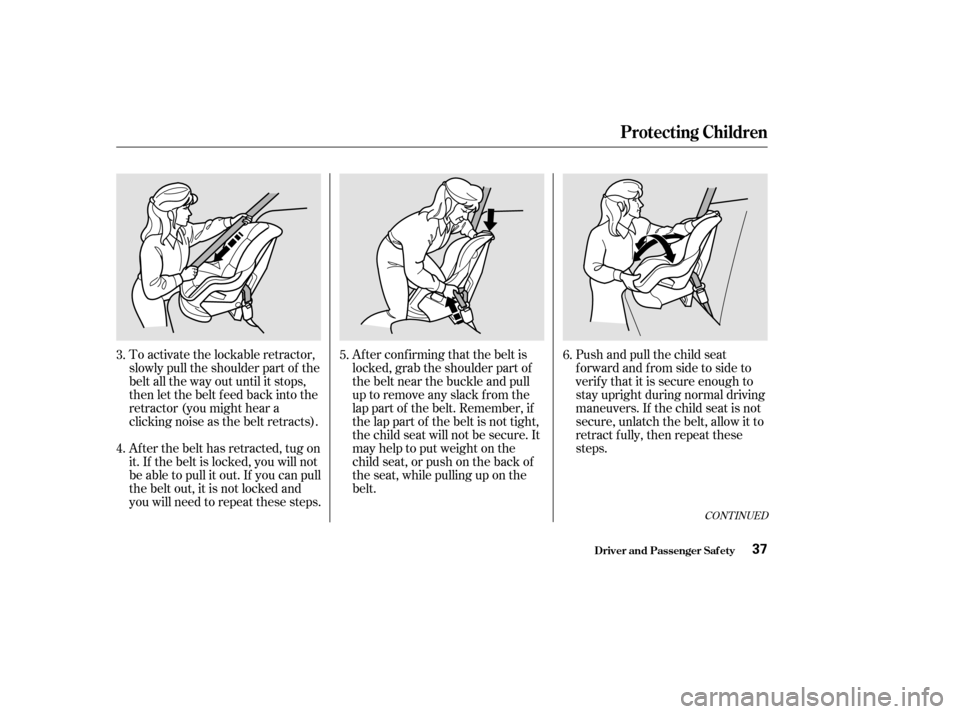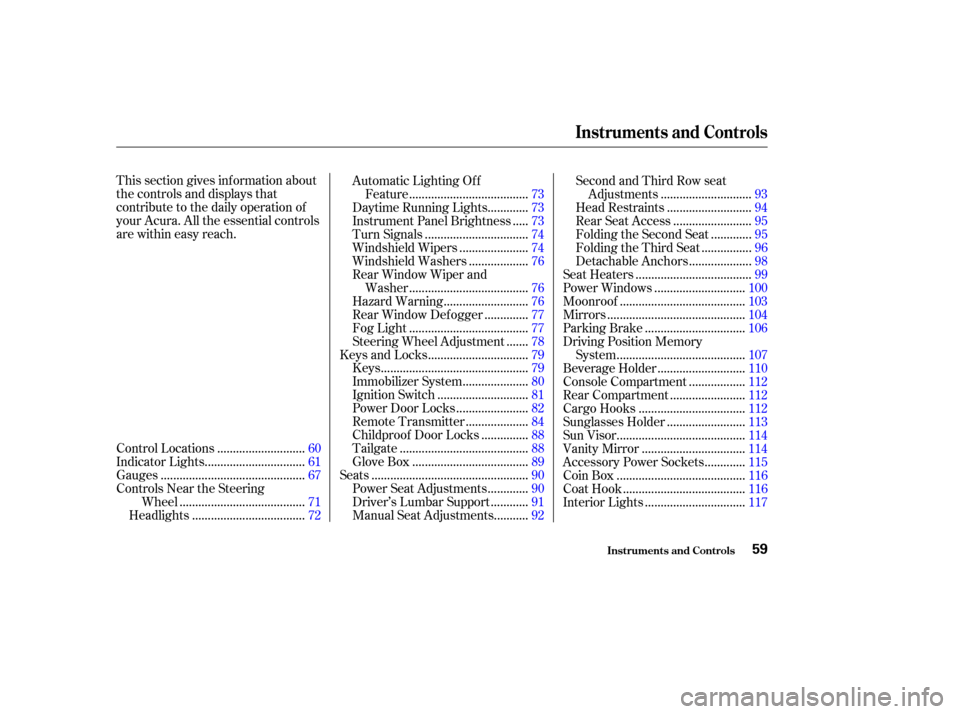lock Acura MDX 2002 User Guide
[x] Cancel search | Manufacturer: ACURA, Model Year: 2002, Model line: MDX, Model: Acura MDX 2002Pages: 372, PDF Size: 5.48 MB
Page 38 of 372

Forproperprotection,aninfantmust
ride in a reclined, or semi-reclined
position. To determine the proper
reclining angle, check with the baby’s
doctor or f ollow the seat maker’s
recommendations.
To achieve the desired reclining
angle, it may help to put a rolled up
towel under the toe of the child seat,
as shown.When properly installed, a rear-
f acing child seat may prevent the
driver or a f ront-seat passenger f rom
moving the seat as far back as
recommended (see page ). Or it
may prevent them f rom locking the
seat-back in the desired upright
position (see page ).
In either case, we recommend that
you place the child seat in another
back seating position, or leave the
af f ected seat unoccupied. If the
problem cannot be solved, you may
wish to get a smaller rear-f acing
child seat.
12
13
Rear-Facing Child Seat Inst allat ion Tips
Protecting Children
Driver and Passenger Saf ety34
01/09/07 12:01:09 31S3V610_039
Page 40 of 372

The lap/shoulder belts in the outer
back and f ront passenger seating
positions have a locking mechanism
that must be activated to secure a
child seat.
The f ollowing pages provide
instructions on how to secure a
f orward-f acing child seat with this
type of seat belt.With the child seat in the desired
seating position, route the belt
through the child seat according
to the seat maker’s instructions,
then insert the latch plate into the
buckle.
If you have a child seat designed
to attach to the vehicle’s
LATCH anchorage system,
f ollow the instructions on page
.
Bef ore installing a child seat in the
center seat of the second row or
either of the third row seats, make
sure the seat belt detachable
anchor is latched (see page ).
If it is necessary to put a f orward-
f acing child seat in the f ront, move
the vehicle seat as far to the rear as
possible, be sure the child seat is
f irmly secured to the vehicle, and the
child is properly strapped in the seat.
1.2.
44
98
Inst alling a Child Seat wit h a L ap/Shoulder Belt
Protecting Children
Driver and Passenger Saf ety36
Improperly placing a forward-
facing child seat in the front
seat can result in serious injury
or death if the front airbags
inflate.
Ifyoumustplaceaforward-
facing child seat in front, move
the vehicle seat as far back as
possible and properly restrain
the child.
01/09/07 12:01:29 31S3V610_041
Page 41 of 372

Push and pull the child seat
f orward and f rom side to side to
verif y that it is secure enough to
stay upright during normal driving
maneuvers. If the child seat is not
secure, unlatch the belt, allow it to
retract f ully, then repeat these
steps.
Af ter conf irming that the belt is
locked, grab the shoulder part of
the belt near the buckle and pull
up to remove any slack from the
lap part of the belt. Remember, if
the lap part of the belt is not tight,
the child seat will not be secure. It
mayhelptoputweightonthe
child seat, or push on the back of
the seat, while pulling up on the
belt.
To activate the lockable retractor,
slowly pull the shoulder part of the
belt all the way out until it stops,
then let the belt f eed back into the
retractor (you might hear a
clicking noise as the belt retracts).
Af ter the belt has retracted, tug on
it. If the belt is locked, you will not
be able to pull it out. If you can pull
the belt out, it is not locked and
you will need to repeat these steps.
3.
4.
5. 6.
CONT INUED
Protecting Children
Driver and Passenger Saf ety37
01/09/07 12:01:39 31S3V610_042
Page 42 of 372

When a child reaches the
recommended weight or height limit
for a forward-facing child seat, the
child should sit in the back seat and
wear a lap/shoulder belt.
If a child is too short f or the shoulder
part of the belt to properly f it, we
recommend that the child use a
booster seat until the child is tall
enough to use the seat belt without a
booster.
The f ollowing pages give
instructions on how to check proper
seat belt f it, what kind of booster
seat to use if one is needed, and
important precautions f or a child
who must sit in the f ront seat.
To deactivate the locking
mechanism in order to remove a
child seat, unlatch the buckle,
unroute the seat belt, and let the belt
fully retract.
Protecting L arger Children
Protecting Children
Driver and Passenger Saf ety38
Allowing a larger child to sit
improperly in the front seat can
result in injury or death if the
passenger’s front airbag inflates.
If a larger child must sit in front,
make sure the child moves the
seat as far back as possible
and wears the seat belt properly.
01/09/07 12:01:48 31S3V610_043
Page 51 of 372

The seat belts in all seating positions
except the driver’s have an additional
locking mechanism that must be
activated to secure a child seat. (See
pages and f or instructions on
how to secure child seats with this
type of seat belt.)
If the shoulder part of the belt is
pulled all the way out, the locking
mechanism will activate. The belt
will retract, but it will not allow the
passenger to move f reely.
To deactivate the locking
mechanism, unlatch the buckle and
let the seat belt f ully retract. To
ref asten the belt, pull it out only as
f ar as needed.
See page f or instructions on how
to wear the lap/shoulder belt
properly.
To fasten the belt, insert the latch
plate into the buckle, then tug on the
belt to make sure the buckle is
latched.
To unlock the belt, push the red
PRESSbuttononthebuckle.
Guide the belt across your body so
that it retracts completely. After
exiting the vehicle, be sure the belt
is out of the way and will not get
closed in the door.
All seat belts have an emergency
locking retractor. In normal driving,
the retractor lets you move f reely in
your seat while it keeps some
tension on the belt. During a collision
or sudden stop, the retractor
automatically locks the belt to help
restrain your body.15
31 36
Additional Inf ormation About Your Seat Belts
Driver and Passenger Saf ety47
01/09/07 12:03:10 31S3V610_052
Page 63 of 372

This section gives inf ormation about
the controls and displays that
contribute to the daily operation of
your Acura. All the essential controls
are within easy reach............................
Control Locations .60
...............................
Indicator Lights .61
.............................................
Gauges .67
Controls Near the Steering
.......................................
Wheel .71
...................................
Headlights .72 Automatic Lighting Off
.....................................
Feature .73
............
Daytime Running Lights .73
....
Instrument Panel Brightness .73
................................
Turn Signals .74
.....................
Windshield Wipers .74
..................
Windshield Washers .76
Rear Window Wiper and
.....................................
Washer .76
..........................
Hazard Warning .76
.............
Rear Window Def ogger .77
.....................................
Fog Light .77
......
Steering Wheel Adjustment .78
...............................
Keys and Locks .79
..............................................
Keys .79
....................
Immobilizer System .80
............................
Ignition Switch .81
......................
Power Door Locks .82
...................
Remote Transmitter .84
..............
Childproof Door Locks .88
........................................
Tailgate .88
....................................
Glove Box .89
.................................................
Seats .90
............
Power Seat Adjustments .90
...........
Driver’s Lumbar Support .91
..........
Manual Seat Adjustments .92 Second and Third Row seat
............................
Adjustments .93
..........................
Head Restraints .94
........................
Rear Seat Access .95
............
Folding the Second Seat .95
...............
Folding the Third Seat .96
...................
Detachable Anchors .98
....................................
Seat Heaters .99
............................
Power Windows .100
.......................................
Moonroof .103
...........................................
Mirrors .104
...............................
Parking Brake .106
Driving Position Memory
........................................
System .107
...........................
Beverage Holder .110
.................
Console Compartment .112
.......................
Rear Compartment .112
.................................
Cargo Hooks .112
........................
Sunglasses Holder .113
........................................
Sun Visor .114
................................
Vanity Mirror .114
............
Accessory Power Sockets .115
........................................
Coin Box .116
......................................
Coat Hook .116
...............................
Interior Lights .117
Instruments and Controls
Inst rument s and Cont rols59
01/09/07 12:04:59 31S3V610_064
Page 67 of 372

This indicator comes on f or a f ew
seconds when you turn the ignition
switch ON (II). It will then go of f if
you have inserted a properly-coded
ignition key. If it is not a properly-
coded key, the indicator will blink
and the engine will not start (see
page ).
This indicator also blinks several
times when you turn the ignition
switch f rom ON (II) to ACCESSORY
(I) or LOCK (0).
This light normally comes on f or a
f ew seconds when you turn the
ignition switch ON (II), and when
the ignition switch is turned to
START (III). If this light comes on at
any other time, there is a problem in
theABS.If thishappens,takethe
vehicle to your dealer to have it
checked. With the light on, your
vehicle still has normal braking
ability but no anti-lock. For complete
inf ormation, see page .
This light has two f unctions:
This indicator comes on when you
turn the ignition switch ON (II). It
is a reminder to check the parking
brake. Driving with the parking
brake not f ully released can
damage the brakes and tires.
If the indicator remains lit after
you have f ully released the
parking brake while the engine is
running, or if it comes on while
driving, it can indicate a problem
in the brake system. For complete
inf ormation, see page .
1.
2.
80
331 221
Indicator L ights
Inst rument s and Cont rols
Immobilizer System
Indicator
Anti-lock Brake System
(A BS) Indicator
Parking Brake and Brake System
Indicator
63
U.S. Canada
Canada
U.S.
01/09/07 12:05:42 31S3V610_068
Page 76 of 372

If you leave the lights on with the
ignition switch in ACCESSORY (I)
or LOCK (0), you will hear a
reminder chime when you open the
driver’s door.
To change between low beams and
high beams, pull the turn signal lever
until you hear a click, then let go.
The blue high beam indicator will
light (see page ).To f lash the high beams, pull the
turn signal lever back lightly, then
release it. The high beams will come
on and go of f .
The high beams will stay on f or as
long as you hold the lever back, no
matter what position the headlight
switch is in.
The rotating switch on the lef t lever
controls the lights. Turning this
switch to the ‘‘ ’’ position turns
on the parking lights, taillights,
instrument panel lights, side-marker
lights, and rear license plate lights.
Turning the switch to the ‘‘ ’’
position turns on the headlights. 65
Controls Near the Steering Wheel
Inst rument s and Cont rols
Headlights
72
01/09/07 12:07:13 31S3V610_077
Page 77 of 372

The lights will turn on again when
you unlock or open the driver’s door.
If you unlock the door, but do not
open it within 15 seconds, the lights
will go off. With the driver’s door
open, you will hear a lights-on
reminder chime.
With the headlight switch off, the
high beam headlights come on with
reduced brightness when you turn
the ignition switch to ON (II) and
release the parking brake. They
remain on until you turn the ignition
of f , even if you set the parking brake.
The headlights revert to normal
operation when you turn them on
with the switch.The dial on the instrument panel
controls the brightness of the
instrument panel lights. Turn the dial
to adjust the brightness.
The Automatic Lighting Of f f eature
turns of f the headlights, f og lights,
parking lights, taillights, side marker
lights, license plate lights and
instrument panel lights within 15
seconds of removing the key f rom
the ignition switch and closing the
driver’s door.
This feature activates if you leave
the headlight switch in the or
position, remove the key, open,
then close the driver’s door.
If you remove the key f rom the
ignition switch with the headlight
switch on, but do not open the door
and get out, the lights will turn of f
af ter 10 minutes.
Controls Near the Steering Wheel
Inst rument s and Cont rols
Automatic Lighting Of f Feature
Daytime Running L ights
(Canadian Models)Instrument Panel Brightness
73
I IN
NS STTR
RU UM M E
EN
NT T P
PA
A N
NE EL
L B
BRRIIGGH HT
TN
NE ES
SS S
C
CO ON NTTR
RO OL L D
DI
IAA L
L
01/09/07 12:07:25 31S3V610_078
Page 82 of 372

Push the lever up to lock the
steering wheel in that position.
Make sure you have securely
locked the steering wheel in place
by trying to move it up and down.
To adjust the steering wheel upward
or downward: Push the lever under the steering
column all the way down.
Move the steering wheel to the
desired position, making sure the
wheel points toward your chest,
not toward your f ace. Make sure
you can see the instrument panel
gauges and the indicator lights.
Make any steering wheel adjustment
bef ore you start driving.
3.
4.
1.
2.
See page f or important saf ety inf ormation about how to properlyposition the steering wheel. 18
Controls Near the Steering Wheel
Inst rument s and Cont rols
Steering Wheel A djustment
78
Adjusting the steering wheel
position while driving may
cause you to lose control of the
vehicle and be seriously injured
inacrash.
Adjust the steering wheel only
when the vehicle is stopped.
01/09/07 12:08:09 31S3V610_083